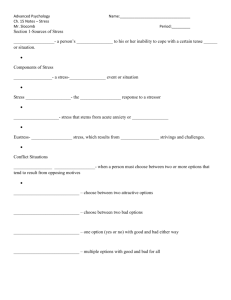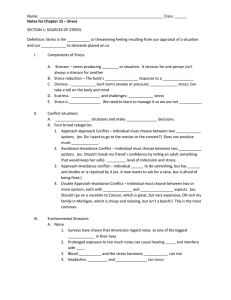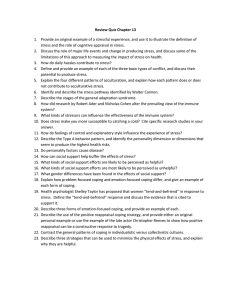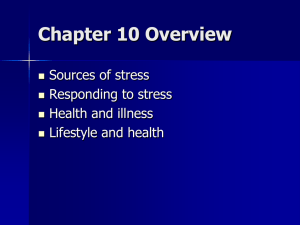CHAPTER OUTLINE 13.doc
advertisement
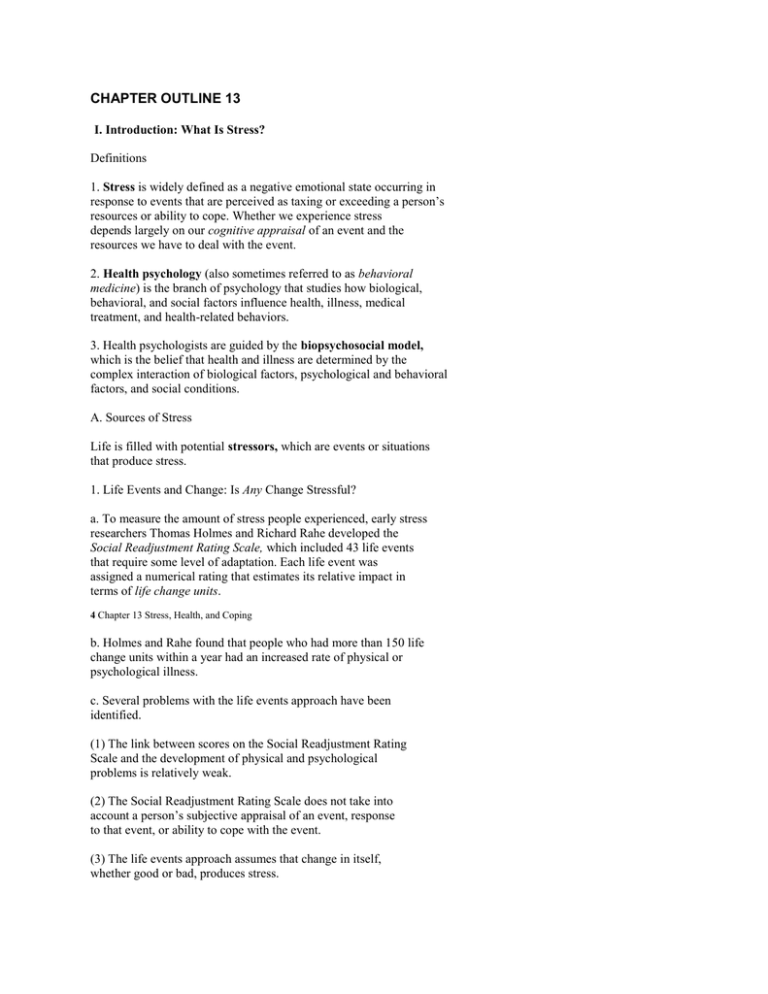
CHAPTER OUTLINE 13 I. Introduction: What Is Stress? Definitions 1. Stress is widely defined as a negative emotional state occurring in response to events that are perceived as taxing or exceeding a person’s resources or ability to cope. Whether we experience stress depends largely on our cognitive appraisal of an event and the resources we have to deal with the event. 2. Health psychology (also sometimes referred to as behavioral medicine) is the branch of psychology that studies how biological, behavioral, and social factors influence health, illness, medical treatment, and health-related behaviors. 3. Health psychologists are guided by the biopsychosocial model, which is the belief that health and illness are determined by the complex interaction of biological factors, psychological and behavioral factors, and social conditions. A. Sources of Stress Life is filled with potential stressors, which are events or situations that produce stress. 1. Life Events and Change: Is Any Change Stressful? a. To measure the amount of stress people experienced, early stress researchers Thomas Holmes and Richard Rahe developed the Social Readjustment Rating Scale, which included 43 life events that require some level of adaptation. Each life event was assigned a numerical rating that estimates its relative impact in terms of life change units. 4 Chapter 13 Stress, Health, and Coping b. Holmes and Rahe found that people who had more than 150 life change units within a year had an increased rate of physical or psychological illness. c. Several problems with the life events approach have been identified. (1) The link between scores on the Social Readjustment Rating Scale and the development of physical and psychological problems is relatively weak. (2) The Social Readjustment Rating Scale does not take into account a person’s subjective appraisal of an event, response to that event, or ability to cope with the event. (3) The life events approach assumes that change in itself, whether good or bad, produces stress. d. Today, most researchers agree that undesirable events are significant sources of stress but that change in itself is not necessarily stressful. 2. Daily Hassles: That’s Not What I Ordered! a. Stress researcher Richard Lazarus and colleagues developed a scale to measure daily hassles—everyday occurrences that annoy and upset people. b. There are gender differences in the frequency and experience of daily stress. (1) One study of married couples found that the women experienced both more daily hassles and higher levels of psychological stress than their husbands did. (2) The most common sources of daily stress for men are financial and job related; for women, the most common sources are family demands and interpersonal conflict. (3) When women experience stress, it is more likely to spill over into interactions with their family; men tend to withdraw. c. The number of daily hassles is linked to both psychological distress and physical symptoms, and it is a better predictor of physical illness than is the number of major life events experienced. d. One reason that daily hassles can take a toll on us is that such minor stressors are cumulative. 3. Social and Cultural Sources of Stress a. When people live in an environment that is inherently stressful, they often experience ongoing, or chronic, stress. People in the lowest socioeconomic levels of society tend to have the highest levels of psychological distress, illness, and death. 4. Culture and Human Behavior: The Stress of Adapting to a New Culture a The process of changing one’s values and customs as a result of contact with another culture is referred to as acculturation. Acculturative stress is the stress that results from the pressure of adapting to a new culture. b There are four possible patterns of acculturation: (1) Integrated individuals continue to value their original cultural customs but also seek to become part of the dominant society; this results in low acculturative stress. (2) Assimilated individuals give up their old cultural identity and try to become part of the new society; this results in moderate acculturative stress. (3) Some individuals follow the separation pattern—they maintain their cultural identity and avoid contact with the new Chapter 13 Stress, Health, and Coping 5 culture. This pattern, which may be self-imposed or the result of discrimination, results in high acculturative stress. (4) Marginalized individuals lack cultural and psychological contact with both cultural groups. This results in the highest level of acculturative stress. 4. Conflict: Torn Between Two Choices Conflict is the feeling of being pulled between two or more opposing desires, motives, or goals. Three basic types of conflicts are described in terms of approach and avoidance. An individual is motivated to approach desirable or pleasant outcomes and to avoid undesirable or unpleasant outcomes. a. An approach–approach conflict represents a win–win situation— you’re faced with a choice between two equally appealing outcomes. Such conflicts are usually easy to resolve and don’t produce much stress. b. More stressful are avoidance–avoidance conflicts—choosing between two unappealing or undesirable outcomes. c. Most stressful are approach–avoidance conflicts—a single goal has both desirable and undesirable aspects. People often vacillate, unable to decide whether to approach or avoid the goal. II. Physical Effects of Stress: The Mind–Body Connection Stress can affect a person’s health either indirectly by prompting behaviors that jeopardize physical well-being or directly by altering bodily functions, leading to symptoms, illness, or disease. A. Stress and the Endocrine System 1. Walter Cannon: Stress and the Fight-or-Flight Response a. The fight-or-flight response is a rapidly occurring chain of internal physical reactions that prepare people either to fight or take flight from an immediate threat. b. It was first described by American physiologist Walter Cannon, who found that the fight-or-flight response involves both the sympathetic nervous system and the endocrine system. c. With the perception of a threat, the hypothalamus and lower brain structures activate the sympathetic nervous system, which stimulates the adrenal medulla to secrete hormones called catecholamines, including adrenaline and noradrenaline. 2. Hans Selye: Stress and the General Adaptation Syndrome a. Canadian endocrinologist Hans Selye was a pioneer in stress research. He found that rats exposed to a variety of prolonged stressors had the same pattern of physical changes: the adrenal glands became enlarged; stomach ulcers and loss of weight occurred; and there was shrinkage of the thymus gland and lymph glands, two key components of the immune system. b. The general adaptation syndrome is Selye’s term for the three-stage progression of physical changes that occurs when an organism is exposed to intense and prolonged stress. (1) During the initial alarm stage, intense arousal occurs as the body mobilizes internal physical resources to meet the demands of the stress-producing event. (2) In the resistance stage, the body actively tries to resist or adjust to the continuing stressful situation. (3) If the stress-producing event persists, the exhaustion stage may occur, leading to exhaustion, physical disorders, and, potentially, death. c. Selye found that prolonged stress activates a second endocrine pathway that involves the hypothalamus, the pituitary gland, and the adrenal cortex. (1) In response to a stressor, the hypothalamus signals the pituitary gland to secrete a hormone called adrenocorticotropic hormone (ACTH). (2) ACTH stimulates the adrenal cortex to release stress-related hormones called corticosteroids, the most important of which is cortisol. (3) In the short run, the corticosteroids help protect the body against the harm caused by stressors. Continued high levels of corticosteroids can lower immunity, increase susceptibility to illness. (4) Chronic stress or repeated episodes of acute stress can lead to cardiovascular disease, including atherosclerosis. Chronic stress can also lead to depression and other psychological problems. 3. Focus on Neuroscience: The Mysterious Placebo Effect a. The placebo effect refers to the benefits that research participants derive from placebos—inactive substances with no known effects. b. To test why placebos reduce pain, researchers placed painfully hot metal on the back of each volunteer’s hand and then injected either an actual opioid painkiller or a saline solution placebo. c. Both groups reported pain relief, and, on PET scans, both groups showed activation of the anterior cingulate cortex, which is known to contain many opioid receptors. d. This study shows that cognitive expectations, learned associations, and emotional responses can have a profound effect on the perception of pain. B. Stress and the Immune System The immune system is the body’s surveillance system that detects and battles foreign invaders. The most important elements of the immune system are lymphocytes—the specialized white blood cells that fight bacteria, viruses, and other foreign invaders. 1. Psychoneuroimmunology a. Psychologist Robert Ader teamed up with immunologist Nicholas Cohen and demonstrated that the immune system response in rats can be classically conditioned. b. Ader and Cohen’s research helped establish a new interdisciplinary field called psychoneuroimmunology, which studies the interconnections among psychological processes (psycho-), the nervous system (-neuro-), and the immune system (-immunology). c. There are many interconnections among the immune, endocrine, and nervous systems. (1) The central nervous system and the immune system are directly linked via sympathetic nervous system fibers, which influence the production and functioning of lymphocytes. (2) The surfaces of lymphocytes contain receptor sites for neurotransmitters and hormones, including catecholamines and cortisol. (3) Lymphocytes themselves produce neurotransmitters and hormones, which influence the nervous and endocrine systems. Chapter 13 Stress, Health, and Coping 7 2. Stressors That Can Influence the Immune System a. Psychologist Janice Kiecolt-Glaser and her husband, immunologist Ronald Glaser, have found that even commonplace negative life events can adversely affect the immune system. b. Their studies investigated the relationship between stress and infection. They found that people who are experiencing high levels of stress were more susceptible to infection by a cold virus than people who were not under stress. Those who experienced chronic stressors were most susceptible. c. Health psychologists have found that a wide variety of stressors are associated with diminished immune-system functioning, increasing the risk of health problems and slowing recovery times. d. Physical health is affected by the interaction of many factors, including heredity, nutrition, health-related habits, access to medical care, and exposure to sources of infection and disease. III. Individual Factors That Influence the Response to Stress A. Psychological Factors 1. Personal Control Research consistently shows that having a sense of control over a stressful situation reduces the impact of stressors and decreases feelings of anxiety and depression. a. If you feel that you can control a stressor by taking steps to minimize or avoid it, you will experience less stress, both subjectively and physiologically. b. In contrast, feeling a lack of control over events produces all the hallmarks of the stress response. c. The perceptions of personal control in a stressful situation must be realistic to be adaptive. d. The benefits of a sense of control are influenced by culture. A sense of control is more highly valued in individualistic, Western cultures than in collectivist, Eastern cultures. 2. Explanatory Style: Optimism Versus Pessimism a. Psychologist Martin Seligman found that how people characteristically explain their failures and defeats makes a difference. (1) People who have an optimistic explanatory style tend to use external, unstable, and specific explanations for negative events. (2) People who have a pessimistic explanatory style use internal, stable, and global explanations for negative events. b. Studies have shown that a pessimistic explanatory style is associated with poorer physical health. 3. Chronic Negative Emotions: The Hazards of Being Grouchy a. Howard S. Friedman and Stephanie Booth-Kewley reported that people who are habitually anxious, depressed, angry, or hostile are more likely to develop a chronic disease. b. Such people experience more stress than do happier people. They also report more frequent and more intense daily hassles, and they react much more intensely, and with far greater distress, to stressful events. 4. Type A Behavior and Hostility a. Cardiologists Meyer Friedman and Ray Rosenman described the Type A behavior pattern as a behavioral and emotional style characterized by a sense of time urgency, hostility, and intense ambition and competitiveness. b. In contrast, people who were more relaxed and laid back were classified as displaying the Type B behavior pattern. c. Friedman and Rosenman classified over 3,000 middle-aged, healthy men, then tracked their health for eight years. They concluded that Type A behavior was a significant risk factor for heart disease. d. Later studies showed that the most critical component of Type A behavior for predicting cardiac disease was hostility, which refers to the tendency to feel anger, annoyance, resentment, and contempt, and to hold negative beliefs about human nature in general. e. High hostility levels increase the likelihood of dying from all natural causes, including heart disease and cancer. (1) Hostile Type As tend to react more intensely to a stressor than other people do. (2) Because of their attitudes, hostile men and women tend to create more stress in their lives. 5. Critical Thinking: Do Personality Factors Cause Disease? a. Psychologists and scientists are cautious in their statements about connections between personality and health, because (1) many studies investigating the role of psychological factors in disease are correlational, (2) personality factors might indirectly lead to disease via poor health habits, and (3) it may be that disease influences a person’s emotions, rather than the other way around. b. Prospective studies are studies that track the health, personal habits, health habits, and other factors of initially healthy subjects over a long period of time. They provide more compelling evidence than do correlational studies. B. Social Factors: A Little Help from Your Friends Social support refers to the resources provided by other people in times of need. 1. How Social Support Benefits Health Social support may benefit our health and improve our ability to cope with stressors in several ways. a. The social support of friends and relatives can modify our appraisal of a stressor’s significance, including the degree to which we perceive it as threatening or harmful. b. The presence of supportive others seems to decrease the intensity of physical reactions to a stressor. c. Social support can influence our health by making us less likely to experience negative emotions. 2. Relationships with others also can be a significant source of stress. a. When other people are perceived as being judgmental, their presence may increase the individual’s physical reaction to a stressor. b. Stress may also increase when well-meaning friends or family members offer unwanted or inappropriate social support. 3. In Focus: Providing Effective Social Support a. There are three broad categories of social support: emotional, tangible, and informational. b. There are several support behaviors that have been identified as helpful; likewise, there are several behaviors perceived as unhelpful. c. Although social support is helpful, it is not a substitute for counseling or psychotherapy. 4. Gender Differences in the Effects of Social Support a. Women may be particularly vulnerable to some of the problematic aspects of social support. (1) Women are more likely than men to serve as providers of support, which can be a very stressful role. (2) Women may be more likely to suffer from the stress contagion effect, becoming upset about negative life events that happen to other people they care about. b. Men tend to rely heavily on a close relationship with their spouse, placing less importance on relationships with other people. Because of their smaller social network, men are more vulnerable to social isolation, especially if their spouse dies. IV. Coping: How People Deal with Stress Coping refers to the ways in which we try to change circumstances, or interpretations of circumstances, to make them more favorable and less threatening. A. Two Ways of Coping: Problem-Focused and Emotion-Focused Coping 1. Coping tends to be a dynamic, ongoing process. 2. When coping is effective, we adapt to the situation and stress is reduced. Maladaptive coping can involve thoughts and behaviors that intensify or prolong distress or that produce self-defeating outcomes. 3. Adaptive coping responses serve many functions. a. They involve realistically evaluating the situation and determining what can be done to minimize the impact of the stressor. b. They involve dealing with the emotional aspects of the situation. c. They are directed toward preserving important relationships during stressful experiences. 4. Psychologists Richard Lazarus and Susan Folkman described two basic types of coping. a. Problem-focused coping is aimed at directly changing or managing a threatening or harmful stressor. Problem-focused coping strategies tend to be most effective when you can exercise some control over the stressful situation or circumstances. b. Emotion-focused coping is aimed at relieving or regulating the emotional impact of a stressful situation. 5. In Focus: Gender Differences in Responding to Stress: “Tend-andBefriend” or “Fight-or-Flight”? a. Physiologically, men and women show the same hormonal and sympathetic nervous system activation in response to stress. b. Behaviorally, men usually fight or flee and women usually tend and befriend. c. According to the evolutionary perspective, the most adaptive response is one that promotes the survival of the individual and his or her offspring. 6. The hormone oxytocin is higher in females than in males. Oxytocinrelated changes seem to help turn down the physiological intensity of the fight-or-flight response for women. 7. Problem-Focused Coping Strategies: Changing the Stressor Problem-focused coping strategies represent actions that have the goal of changing or eliminating the stressor. a. When people use aggressive or risky efforts to change the situation, they are engaging in confrontive coping. b. Planful problem solving involves efforts to rationally analyze the situation, identify potential solutions, and then implement them. 8. Emotion-Focused Coping Strategies: Changing Your Reaction to the Stressor a. The escape–avoidance strategy involves shifting your attention away from the stressor and toward other activities. b. Seeking social support involves turning to friends, relatives, or other people for emotional, tangible, or informational support. c. In distancing, you acknowledge the stressor but attempt to minimize or eliminate its emotional impact. d. Denial is a refusal to acknowledge that the problem even exists. Like the escape strategy, denial can compound problems in situations that require immediate attention. e. The most constructive emotion-focused strategy, positive reappraisal, occurs when you not only try to minimize the negative emotional aspects of the situation but also try to create positive meaning by focusing on personal growth. f. The most effective coping is flexible, that is, fine-tuning one’s coping strategies to meet the demands of a particular situation. g. People often use multiple coping strategies in stressful situations, combining problem-focused and emotion-focused strategies. B. Culture and Coping Strategies 1. Members of individualistic cultures tend to emphasize personal autonomy and personal responsibility in dealing with problems; thus, they are less likely to seek social support in stressful situations than are members of collectivistic cultures; they favor problemfocused strategies. 2. In collectivistic cultures, however, a greater emphasis is placed on controlling personal reactions to a stressful situation than on trying to control the situation itself; thus, people in these cultures favor emotion-focused strategies. V. Application: Minimizing the Effects of Stress A. Exercise Regularly B. Avoid or Minimize the Use of Stimulants C. Get Enough Sleep D. Practice a Relaxation Technique
